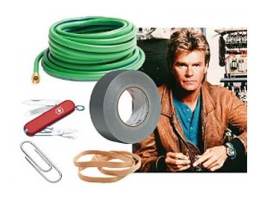I have been enamored with the concept of bricolage for some time now. French for “tinkering”, bricolage is the building of something from what is available. Sherry Turkle applied this to programming, suggesting less an exhaustive specification than a iterative growth process with re-evaluation loops. Turkle writes:
“The bricoleur resembles the painter who stands back between brushstrokes, looks at the canvas, and only after this contemplation, decides what to do next.”
 In the late 1980s, we were all introduced to this concept when each week we tuned in to the television show MacGyver. MacGyver could solve any problem with the materials laying around him.
In the late 1980s, we were all introduced to this concept when each week we tuned in to the television show MacGyver. MacGyver could solve any problem with the materials laying around him.
This idea is a nice metaphor for how the web has evolved in the past decade. There are now many options for content creation, communication, sharing, and community building laying all over the interwebs…as some of my colleagues call it. Over the past five years, we in the Center for Teaching Excellence have tinkered a lot as we explored digital technologies that were now available and probed how they might be useful in an educational context.
Stephen Downes shared a link from Inge de Waard yesterday which summarize a new report released from the Technology Enhanced Learning Research Programme out of the UK that explored building online learning solutions that are durable – Beyond Prototypes: Enabling Innovation in Technology-Enhanced Learning.
Stephen’s synthesis of this report:
- “TEL involves a complex system of technologies and practices…it is necessary to look beyond product development and pay close attention to the entire process of implementation.
- Significant innovations are developed and embedded over periods of years rather than months. Sustainable change is not a simple matter of product development, testing and roll-out.
- TEL innovation is a process of bricolage… It also requires engagement with a range of communities and practices.
- Successful implementation of TEL innovation requires evidence that the projected educational goal has been achieved.”
This resonated with me. We are in the process of updating our Online Course Development Initiative at VCU. The OCDI has evolved over the years into a “…complex system of technologies and practices” that does span years rather than months:
- An online sensitizing activity before joining a cohort to surface preconceived beliefs about online teaching and learning.
- A week-long cohort process to build community and explore online teaching practices and processes.
- A three-week online experience to better understand collaborative learning and co-construction of knowledge from the perspective of a student
- A long-term relationship with a design consultant to develop and teach an online course, providing pacing for development and a safety net for exploration.
- Teaching the course for the first time and reflecting on successes and challenges
- Redesign of the course, taking into account the data collected during the first iteration.
Over the past four years, we have engaged 77 faculty members in the development of 74 courses. Yet I would suggest that we are only in the early days of “sustainable change.” Some of these courses are still under development or have not yet been redeveloped. We have the beginnings of a community. As we move forward, we need to continue the process of bricolage…engaging with and building this community.
As part of that tinkering, we should keep Lisa Lane’s comment this week in mind:
“We think of our online classes as being on the web, but most of them aren’t on the web – they’re inside an LMS, isolated from the internet. New online instructors often sense this sterility and add images and videos. But the images are often decorative rather than instructional, and the videos are now embedded, which is great for convenience and less distraction but less suitable for exploration…
…Where are the structured web spaces, the ones where we as teachers know what’s there, but where students can explore? Databases full of primary sources are boring. Where is the equivalent of installation art, where the artist defines the space but the interpretations and experience are left to the viewer?”
Great questions! The UK report above has some interesting observations:
“…the tools of educational technology have no magical power in themselves, only by being embedded in the practices of teachers and learners do their mediational means come into play…”
“…Technology should only ever be considered as supportive of educational practice, never as core to it…”
“…successful innovations in TEL [technology enhanced learning] are often not new inventions. They more often involve assembly of technological elements and practices, most of which already exist, into novel configurations, applied in new settings…”
The model presented in the UK report suggests the complexity in creating a sustainable online practice:
The UK report suggests that it is a misconception to think of “technology” as the innovation. The innovation is in the mindful use of the technology. Creating that mindfulness takes time, tinkering, and…as the report suggested…”persistent intent.”
So my 30-Day Challenge question today is:
Day 24 – How might my teaching practice be informed and sustainably changed for the better by tinkering with open resources on the web?
…keeping in mind – stay focused on the learning, not the cool tools…
Thoughts?
Graphics: Box Theory, tel.ioe.ac.uk}

